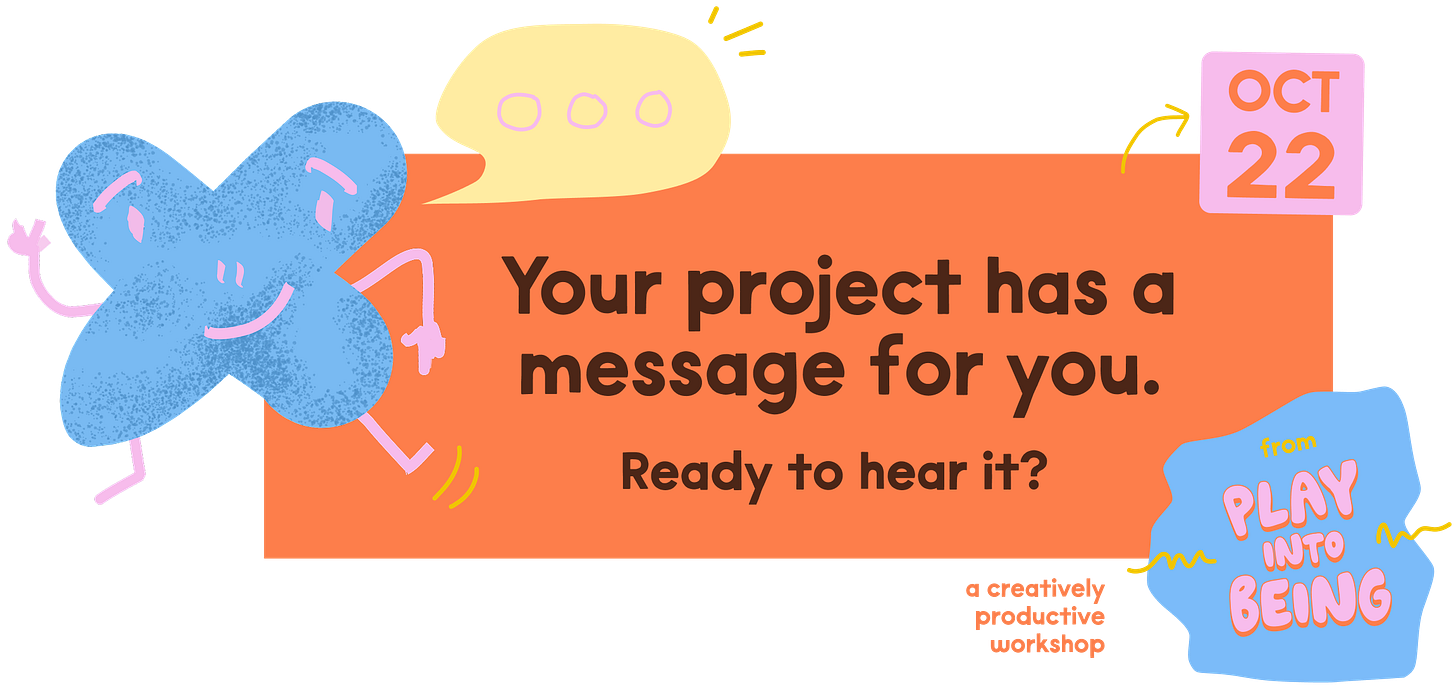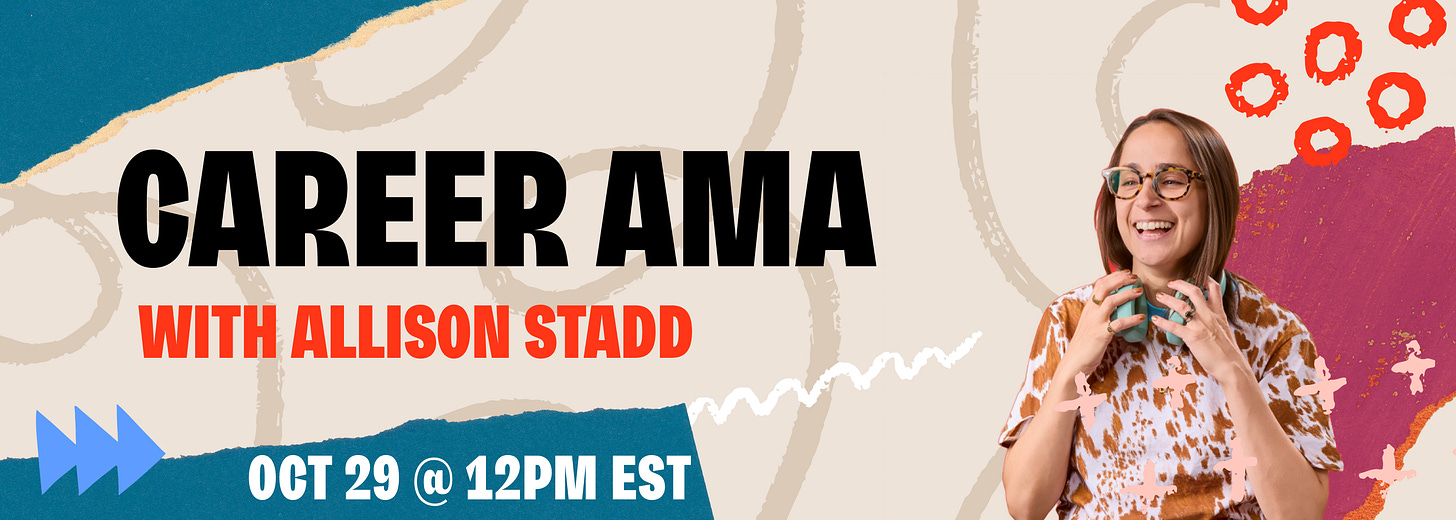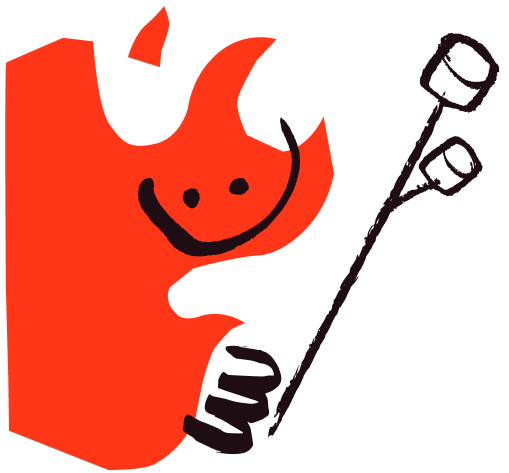The crucial difference between 'running from' and 'running toward'
And why our propensity for one keeps us stuck
Hi there! You’re reading the Bonfire newsletter from Kevan Lee & Shannon Deep. Each week, we highlight brand, marketing, and creative learnings from our experience as in-house marketers turned agency owners who think a lot about creativity, our relationship to work, and how all of that impacts our identities. We’ll also feature insights from our digital community of super smart folks (which you’re welcome to join).
Wishing you a great week!
I ran away from my first full time job.
I fled after a tragic situation involving a close colleague, followed by two rounds of layoffs in rapid succession in which the vast majority of those laid off were women over 40, including my boss. (I was 29 and not laid off, but it didn’t send a promising message or show much social awareness.)
After all that, this workplace had an inescapably negative charge for me, made all the more poignant by the fact that just a few months prior I unabashedly loved that job, my colleagues, and the company.
When I say I “ran away,” I mean I jumped on the very first opportunity that came along, one I hadn’t even been looking for, in the form of a slimy recruiter who’d cold DMed me on LinkedIn. I ignored all the weird vibes and red flags during the interview process and found myself at an almost laughably horrible company: an openly misogynistic CEO with a racecar-themed office (not a joke); an openly bigoted head of strategy; senior colleagues who screamed at one another in their offices while we sat directly in front of their doors; instructions to lie to clients about the size of the company. I could go on!
I left after 3 months.
And this is when I learned the importance of running toward something I wanted instead of running from something I didn’t.
What we lose when we only run from
At the retreat we recently hosted, one of our session leaders,
, led us in an exercise around this very idea. We’d just spent the last two days’ sessions exploring our definitions of success, our values, our blocks, and now we were concretizing what we’d uncovered.First, we journaled around these questions:
What are you running from in your current work-life situation? What feelings are you trying to escape? What consistently drains your energy?
At the risk of going full confessional poet on you (love you, Anne Sexton!), here are some of my verbatim entries from this exercise:
I’m running from obligations—things that feel like I have to do them vs. want or need to do them. Running from Zoom calls, synchronous time that I have to be on a computer. Running from an identity as someone who does knowledge work and my attachment to the prestige that comes along with it. Away from closed-inness, tightness, cramped spaces, a stressful pace. Away from financial stress. Away from scarcity mindset, fear of financial struggle. Away from feeling like I’m on a timeline or clock. Away from hyper-independence and the belief that my relationships are fragile.
That’s a lot of stuff I don’t want! And it’s really valuable to list it all out like this, to pick out the themes (my obvious craving for freedom and control!), and see how the professional things I’m running from overlap and intertwine, inextricably, with my personal life.
And as valuable as all of that is, it doesn’t give me a particularly crisp picture of what I actually want. “Not this” is powerful, but it’s also unspecific; there are a lot of things that aren’t this! If we were to consider my job example, I was running away from reminders of grief, from feelings of injustice and inhumane management, from organizational chaos and lack of control over my own future, from likely pay freezes. And because I was so focused on getting away from that situation, I ran to something that filled the requirement of being “not this”—and it was just as bad, if not worse.
The image I have in my head is being in a pitch black field, and the only thing you can see is the swampy pit of thorny vines all around you…so you just go tearing into the blackness in any direction.
Instead, what if there were a bright spot on the horizon—higher, drier ground? What if there was a crescent moon, illuminating a cozy little cabin just beyond the mud and crocodiles?
That’s why figuring out the second half of this equation is worth the time!
How to know what you’re running toward
At our retreat, we didn’t stop at the first question, of course! Sam’s second prompt for us was this:
What are you running toward in the work-life scenario you want for your future? What values and feelings do you want to embody? What impact do you want to have? Bonus: What’s a typical Tuesday look like in this future?
Like Kevan talked about last week with roadmaps vs. lilypads, this prompt is great for identifying some “lilypads” you want to jump to: places you want to go, but not necessarily how to get there, or a particular timeline for doing so.
My exercise looked like this:
Running toward:
Lots of AUTONOMY—my day is MINE, I spend it how I want to spend it
Learning to let go, let others, not take it personally
Being less precious and more experimental
Presence and joy
Artistry and creativity
Impact: To create and hold space for people to be exactly who they want.
Not very specific, is it? Or rather, it’s not specific in the content, but rather the form. I’m running toward being experimental, not X, Y, Z experiments. I’m running toward artistry and creativity, not one particular creative project. While this doesn’t give me a roadmap, this gives me a filter through which I can view all paths and opportunities. A choice opens up, and I can hold it up against this vision and see if it checks these boxes. Does this new line of business give me opportunities to experiment? Does structuring Bonfire work differently allow for more autonomy and presence in my life? Does leaning into a tricky friendship give me an opportunity to practice letting go?
You get it.
If we go back to my job jumping example, if I had a list of what I was running toward, it might have looked like this:
Empathetic senior leadership
A stable work environment
Colleagues I feel I can connect with on a human level
Better pay
Values-aligned work
The job I took? Yeah, it would only have checked the “better pay” box.
Looking to kickstart a creative project?
Check out this new workshop from creative productivity studio Play Into Being and get in touch with the energy around your ideas!
When’s the right time to ask these questions?
Behavioral scientists will tell you that motivation, while complex, is heavily influenced by avoiding pain and seeking pleasure. But they’ll also tell you that the pain avoidance mechanism tends to be stronger than the pleasure seeking! A related cognitive bias here is loss aversion: Losing $10 is more painful than not winning $10, meaning that people perceive that it’s the worse outcome.
This suggests that when we find ourselves in painful situations, when we know there’s something we definitely want to run from, and when the rewards aren’t obvious or guaranteed, we go into “Don’t lose the $10!” mindset instead of “...how might I win $10?” One is instinctive, reactive, and immediate, and the other involves insight, planning, time, and activating the pleasure-seeking, risk-reward-analyzing parts of the brain.
Our psyches are screaming “GO GO GO!” so loudly that the voice saying “Wait…but where?” is drowned out.
So maybe the key here is to do these exercises periodically, regardless of whether you’re currently in a crossroads or not. That way, you always have a North Star. You never have to build your filter on the fly…while you’re fleeing!
Over to you
Have you done exercises like this before? Have they come in handy? We’d love to hear about it in the comments or over in our Campout community!
Events, resources, and more
Events 🗓️
Career AMA w/ Allison Stadd - FREE public event!
Wednesday, October 29, at noon Eastern
Our very first Career AMA features
, author of The OffBeat, jazz drummer, AND CMO at Ollie and former marketing and brand leader at Shipt, Shake Shack, Sweetgreen, and more.Resources 🛠️
DIY Mini-Sabbatical Workbook - For Campout members
Our newest Campout resource is a workbook for helping you plan ways to rest and recharge even when you can’t take a whole year off. Check it out if you’re looking for ways to be more intentional with your downtime!
Brand marketing courses & templates - In our Gumroad storefront
From AI search optimization to brand reach tracking and personal positioning, get our detailed how-tos for a couple bucks each.
But wait! There’s more…
Wanna hang out in person?
New retreat dates are coming soon. You can join the waitlist for our next one, coming spring of 2026.
Wanna be friends?
If you love this newsletter and wish it were more interactive, you’re in luck! Join us over in Campout, our digital community for creative marketers and the creative curious.
Wanna work with us?
If you need help with brand strategy and storytelling, fractional brand and marketing leadership, and bringing your brand strategy to life in impactful ways, send us an email at hello@aroundthebonfire.com to get in touch.
As always, you can find us on LinkedIn, Instagram, and Threads.






